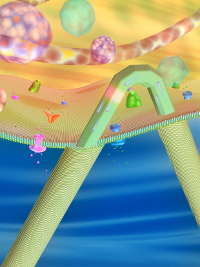美国哈佛大学著名纳米科学家查尔斯•利伯(Charles Lieber)最近在《科学》杂志报道了一种新的病毒级探针,该探针使得科学家最终实现了对细胞内活动的监测,却不破坏细胞膜。这个新的探针是一种纳米级场效应晶体管(nanoFET),当它接触或插入细胞时能够检测到电信号的变化。以前的纳米级晶体管局限于二维,只能检测到细胞外部的电信号变化;而nanoFET具有独特的三维造型以及极小的尺寸。此外,nanoFET探针表面覆盖着脂双层,它能够融入细胞膜,使得探针末端能够进入细胞并监测胞内活动,而不影响胞内结构和活性。

探针进入细胞示意图
利伯及其同事目前正利用该探针研究神经元,期望能够实时监测细胞内特殊蛋白的活性。利伯表示,虽然nanoFET制造复杂,但是不久它就会发展成一种普遍应用的工具。
乔治亚理工学院著名材料学家王中林说:“从技术角度和胞内生物学角度来看,该工具将产生巨大影响。”
生物探索推荐英文摘要
Science DOI: 10.1126/science.1192033
Three-Dimensional, Flexible Nanoscale Field-Effect Transistors as Localized Bioprobes
Abstract:Nanoelectronic devices offer substantial potential for interrogating biological systems, although nearly all work has focused on planar device designs. We have overcome this limitation through synthetic integration of a nanoscale field-effect transistor (nanoFET) device at the tip of an acute-angle kinked silicon nanowire, where nanoscale connections are made by the arms of the kinked nanostructure, and remote multilayer interconnects allow three-dimensional (3D) probe presentation. The acute-angle probe geometry was designed and synthesized by controlling cis versus trans crystal conformations between adjacent kinks, and the nanoFET was localized through modulation doping. 3D nanoFET probes exhibited conductance and sensitivity in aqueous solution, independent of large mechanical deflections, and demonstrated high pH sensitivity. Additionally, 3D nanoprobes modified with phospholipid bilayers can enter single cells to allow robust recording of intracellular potentials.







